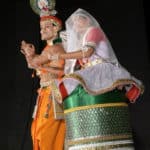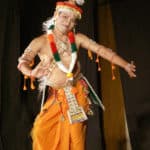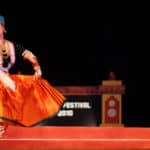Also known as “Jagoi” is a classical Indian dance form popularly referred to as Manipuri Dance. This “Raslila” (i.e. dance-drama based on Krishna-Radha love story) based dance form has originated from Manipur, a state located in the northeast of India. In addition, this dance form is also said to be closely linked to ancient Hindu traditions such as Shaivism and Shaktism. Furthermore, this dance style is also renowned for its “graceful and extremely fluid movements”. This ancient dance form is also said to have been passed on from one generation to another verbally.
a. History and origin of the Manipuri Dance:
According to a few historical texts this dance form is said to have emerged during the early 18th century. It is also said that the roots of this dance form has been derived from the ancient Sanskrit sacred text “Natya Shastra” similar to many other Indian classical dance forms. In addition, a local text known as “Bamon Khunthok” states that this dance form was developed as a result of the then “King of Manipur” adopting principles of Vaishnavism during the 15th century. It was not until the late 17th century though that this dance form was for the first time officially codified via documentation by Maharaja Bhagyachandra. Furthermore, it was this codification that paved the way for further development of this elegant dance form.
b. Costume used in the Manipuri Dance:
Depending on whether the performer is a male or female the costume varies, and they are as follows:
1. For males:
The attire mainly includes a dhoti/dhotra/dhora wrapped around the waist. In addition, peacock feathered crown is usually worn in case the performer is conveying a story related to Lord Krishna.
2. For females:
The attire essentially includes a Kumil i.e. a barrel shaped and decorative long skirt, velvet blouse, a white translucent veil to cover the head, jewellery adorning the face, neck, waist, hands, and legs along with a garland of flowers.
c. Music used in the Manipuri dance:
The music accompanying this dance form is essentially produced using a percussion instrument known as “Pung” i.e. a barrel drum. In addition, this dance form is also accompanied by instruments such as cymbals, sembong harmonium, pena i.e. a stringed instrument, and flute i.e. a wind instrument as well as singing. Furthermore, the lyric of the song that is rendered during this dance performance normally makes use of classical poetry written by poets such as Jayadeva, Vidyapati, Chandidas, and Govindadas.
d. Training availability and dance technique of the Manipuri dance:
In terms of technique, the Manipuri dance comprises of three styles. The three styles are as follows:
1. Tal Rasak:
This style basically consists of performers clapping their hands in unison while dancing.
2. Danda Rasak:
This style comprises of performers dancing with sticks in synch with the accompanying music.
3. Mandal Rasak:
This style essentially is based on “Lord Krishna” wherein the “Gopis” i.e. females are positioned in a circle, who dance around the lead character i.e. Krishna.
As for training centres, there are a number of schools/centres available throughout the country that provide for the essential basics of this beautiful dance form for all those interested in it.





